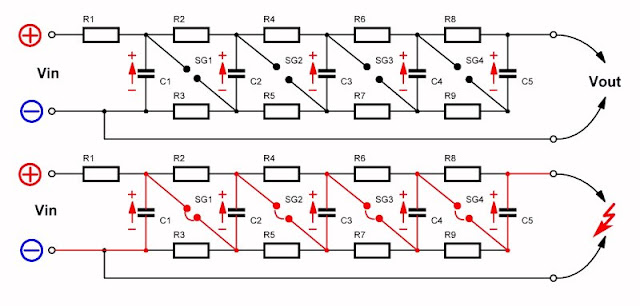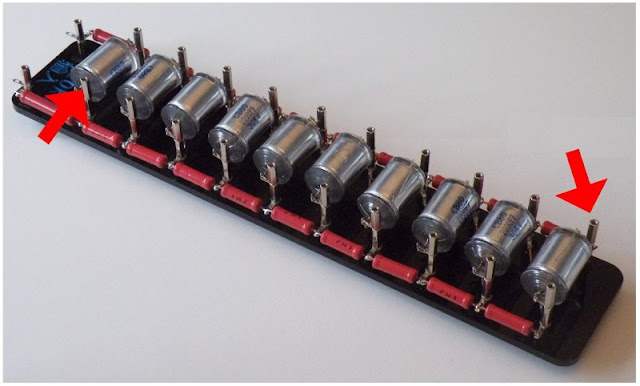
|
This is an article for the fanatical spark enthusiasts among our readers! With the described kit of a ten-stage Marx generator, you can generate sparks up to 15 cm without any effort. |
Introduction to the ten-stage Marx generator
The result of this kit
To give you an idea of what to expect from this rather pricey DIY kit, we made a video.
As you can see in the picture below, this DIY project consists of several components:
As you can see in the picture below, this DIY project consists of several components:
- A power supply capable of delivering 24 V at 10 A.
- A so-called ZVS flyback driver.
- A high voltage transformer with rectifier.
- The kit of the ten-stage Marx generator.
All together you should count on a price of about one hundred and ten euros:
- € 19.07 for the power supply.
- € 18.75 for the ZVS flyback driver with transformer
- € 70.90 for the kit of the Marx generator.
 |
| The full demonstration setup of the Marx generator. (© 2023 Jos Verstraten) |
What is a Marx generator?
A Marx generator is basically a special version of a voltage multiplier. You power such a circuit with a input voltage Vdc, the circuit turns it into x times Vdc, where x represents the number of stages of the generator. The circuit was first described in 1924 by German engineer Erwin Otto Marx.
In a Marx generator, in a simple and ingenious way, a number of capacitors are charged in parallel from the input voltage and then discharged in series. In practice, the generator consists of identical capacitors C charged via resistors R. Between the capacitors there are spark gaps SG. At the moment when the voltage across the capacitors exceeds a certain value, the spark gaps will spark one after another and momentarily form a jumper between the capacitors.
The capacitors then end up in series and the output voltage becomes almost equal to the sum of the voltages across the individual capacitors. For example, if each capacitor is charged to 20 kV, a ten-stage Marx generator very briefly produces an output voltage of no less than 200 kV. You can draw nice sparks with that!
 |
| The working principle of a Marx generator. (© 2023 Jos Verstraten) |
The operation of the circuit
Very important for operation is that the first spark gap SG1 is slightly smaller than the others. Assume that all capacitors are discharged and you connect the input voltage to the circuit. The capacitor C1 will now start charging through the resistor R1. Capacitor C2 does the same via resistors R1, R2 and R3. Thus, this charging is slightly slower than that of C1. Similarly, all capacitors start charging via the resistors connected in series. However, charging is always slightly slower. As long as charging currents flow through the resistor R1, the voltage across C1 will be smaller than the supply voltage Vin. This is because the currents cause a voltage drop across the resistor. Only when all capacitors C2 through C5 are fully charged can C1 also charge to the input voltage. Only the charging current of C1 flows through the resistor R1 at that time.
The spark gap CG1 has such a small distance between its two electrodes that breakdown occurs when the capacitor C1 is almost charged to Vin. The discharge that occurs between the two electrodes of SG1 ionizes the air between them. The air resistance goes down dramatically and a spark occurs. You can now see that at this point capacitors C1 and C2 are connected in series. Next, the spark gap SG2 should blow. This is caused not only by the voltage across capacitor C2, but also by the flash of light emitted by the spark that had occurred across SG1. In this flash there is UV radiation and this causes the air between the electrodes of SG2 to conduct a little better. In this way, the spark gap's firing propagates from left to right through the circuit.
So after the left-most spark gap blows up, a sort of avalanche effect occurs, causing all the spark gaps to blow up one after another. However, this happens so quickly that you don't notice anything. It seems as if all spark gaps are sparking simultaneously, but they do not.
After the last spark gap SG4 has blown up, a voltage equal to the sum of all capacitor voltages is present on the output. So in this example, there is a voltage on the output that is five times greater than the input voltage. This voltage immediately causes a spark gap between the two wires connected to the output of the Marx generator. If the circuit is properly designed, you can expect sparks as large as fifteen centimeters!
Toy or scientific instrument?
Both! Marx generators are ideal circuits for the hobbyist. After all, they don't require much electronics, and the challenge, of course, is to make longer and longer sparks. We will return to this 'fine-tuning' at the end of this article.
But Marx generators are also scientific instruments used in high-voltage laboratories to artificially generate lightning. You can see an example of such a scientifically used Marx generator in the photo below. Built in 1970, this device is located near the Russian town of Istra in the "Исследовательский центр высоких напряжений" (High Voltage Research Institute) and can generate lightning with a length of 150 meters.
 |
| Example of a scientific Marx generator. (© whereongoogleearth.net) |
Multiple warnings are necessary!
- Warning 1:
If you start tinkering with such circuits, you should take into account that such tinkering is not harmless! At the output of a Marx generator voltages of several hundreds of thousands of volts can be generated and these can be lethal. The capacitors, even after switching off the input voltage, can still carry voltages of hundreds of volts for minutes. So always discharge all capacitors in the circuit with a well-insulated short-circuit wire or wait at least ten minutes before doing anything in the circuit. - Warning 2:
Remember that such sparks generate considerable electromagnetic fields between the discharge electrodes and your sensitive measuring equipment may not be able to withstand them. So do not create sparks on your normal hobby bench where your multimeter and your oscilloscope may be only twenty centimeters away from the Marx generator. Find a place far away from electronic equipment when you spark the generator. - Warning 3:
The entire system draws about 200 W of power from 24 V! That means a current of almost 10 A is flowing primarily. Consider this when connecting the various PCBs of the Marx setup. Use connecting wire with sufficient cross section. Also, don't let the Marx generator spark continuously. Apart from the fact that you would go crazy from the loud bangs caused by the sparks, various components of the system would become much too hot. So use the system only intermittently for demonstration or to perform an experiment.
What do you need when experimenting?
Resistors and capacitors
First, of course, special resistors and capacitors that can withstand voltages of several tens of thousands of volts. If you don't want to buy a kit, you can also buy these parts rather cheaply separately from AliExpress.
The picture below shows a 2,000 pF capacitor with an operating voltage of 30 kV. Such capacitors are also in the kit we bought. You pay about € 2.00 each for them from providers on AliExpress.
 |
| You will need these 2 nF / 30 kV capacitors. (© AliExpress) |
The resistors must also be able to withstand high voltages. In the picture below, you can see the resistors included in the kit. They have a value of 1 MΩ, a power of 2 W, a length of 25 mm and a breakdown voltage of 20 kV. You will pay about € 1.00 each for them.
 |
| The 20 kV resistors included in the kit. (© AliExpress) |
Powering the Marx generator
Next, you need to power the Marx generator with a DC voltage of 20 kV. To do this, the Chinese suppliers of the Marx generator kits used a plain old-fashioned high voltage transformer with rectifier that was in every cathode ray tube TV and generated the acceleration voltage for this tube. Thanks to that high voltage, the electrons from the cathode flew at great speed to the screen of the cathode ray tube. Of course, that transformer must receive a primary AC voltage to generate that high voltage secondary. For sale is a so-called ZVS flyback driver that you can buy ready-made with the special transformer.
The power supply
That ZVS flyback driver also needs to get power from somewhere. You need a power supply that generates a DC voltage of 24 V and is capable of delivering a current of about 10 A. Even such a device you don't build yourself these days but can buy ready-made.
The 24 V / 10 A power supply
The S-250-24 power supply as an example
In principle, you can connect the ZVS flyback driver to any power supply that provides 24 Vdc and has 10 A current capacity. Yet there is a nasty catch. The ZVS flyback driver is an oscillator and it only starts up if the power supply of the circuit is built up very quickly. If you are using a sluggish power supply, for example one with a heavy smoothing capacitor on the output, there is a chance that the oscillator will not start and one of the MOSFETs in the flyback driver will be constantly ON. Your power supply will then be short-circuited and the chance of the MOSFET surviving is very small.
This is why we recommend you buy the power supply we used. It performs very well in combination with the ZVS flyback driver. The type number of this power supply is S-250-24, the brand is Meishile. You will pay about € 20.00 for it. Note that in one of the side panels there is a slide switch that allows you to set the mains voltage to 110 V or 230 V. There is a controlled fan in the power supply, so it will run only when the electronics believe it is necessary.
 |
| The S-250-24 power supply from Meishile. (© AliExpress) |
The ZVS flyback driver with transformer
The ZVS flyback driver circuit board
In the photo below you can see this amazingly small PCB measuring 83 mm by 74 mm yet capable of supplying 200 W of power to the transformer. On the two heatsinks are N-type MOSFETs that drive the two halves of the flyback transformer's primary winding with pulses at a frequency of about 40 kHz.
 |
| The ZVS flyback driver PCB. (© AliExpress) |
The flyback transformer provided is represented in the figure below. At the bottom, around the ferrite core, you can see the two primary coils with only a few windings of wire (blue). Those four blue wires go to the output of the ZVS flyback driver. The secondary coil of the flyback transformer is potted. Somewhere in that section there must also be a diode and a high voltage capacitor. There are two wires coming out of that part. On the right, you can see a solid red wire that went to the TV kathode ray tube. On the left you will see a thinner gray wire that was ground. You need to connect those two wires to the input of the Marx generator.
On the left is a number of solder pins present. In a TV, the flyback transformer, in addition to generating the acceleration voltage, was used for a number of other things. In our application, these pins have no function.
 |
| This flyback transformer provides the 20 kV input voltage for the Marx generator. (© AliExpress) |
Potting the flyback transformer
As the picture above shows, the flyback transformer is quite a spiky thing that is difficult to handle. It does carry a voltage of 20,000 V! That is why we encased the transformer in a plastic freezer box, see photo below. On one of the long sides the four blue wires of the two primary windings come out of the box. We replaced the very stiff red wire from the high voltage side with a smoother wire. The two 20 kV wires come out of the two short sides of the box and can be easily connected to the input of the Marx generator. We did not potting the entire transformer, keeping the top side with the two adjustment screws free.
 |
| The potted flyback transformer. (© 2023 Jos Verstraten) |
The schematic of the ZVS flyback driver
The figure below shows the schematic of the circuit on the small PCB. 'ZVS' is the acronym for 'Zero Voltage Switching'. This circuit is also called the 'Royer/Mazilli oscillator'. However, Karl Baum also claims to be the inventor of this circuit.
When you connect the circuit to the power supply, a current starts flowing through the coil L1 to the center tap of the primary of the transformer. The coil ensures that the turn-on current is not too large. Through the resistors R1 and R2, the supply voltage also goes to the gates of the two MOSFETs. Because there are slight differences in the specifications of the two semiconductors, one of the MOSFETs will conduct slightly faster than the other. Suppose T1 comes into conduction, the drain is connected to the minus of the power supply. A large current is going to flow through the upper primary coil of the transformer. The cathode of the fast diode D1 is also connected through the drain to the minus of the power supply. So the gate voltage of the lower MOSFET disappears, this semiconductor goes to the OFF-state.
As the capacitor C1 is in parallel with the primary coil of the transformer, a resonant tank circuit is created. Because of this action, the drain voltage of the other MOSFET T2 will be more or less sinusoidal. At some point, this voltage becomes equal to zero volts. The diode D2 now starts to conduct and this action causes the gate voltage of T1 to drop. T1 will thus go to OFF and T2 can now receive gate voltage again via the resistor R2 and the reverse diode D1. The lower MOSFET now starts conducting and via the tanking action of the LC circuit, the described cycle repeats itself, but now with a conducting T2 and T1 in the off state.
The resistors R3 and R4 of 1 kΩ are necessary to absorb the excess charges in the gates of the MOSFETs and the zener diodes D3 and D4 limit the voltage at the gates to 12 V.
 |
The schematic of the ZVS flyback driver. (© 2023 Jos Verstraten) |
The oscillograms below show the changes in voltages on the gates and drains of the two MOSFETs.
 |
| The voltages in the circuit. (© 2023 Jos Verstraten) |
The ten-stage Marx generator
The DIY kit
DIY kits of Marx generators are offered through AliExpress. Most suppliers offer both six- and ten-stage versions. Because the sizes of the sparks to be generated are quite different, we choose the ten-stage version. The package is delivered, excellently packaged, in a sturdy cardboard box.
 |
The packaging of the kit. (© 2023 Jos Verstraten) |
The parts supplied
You can see these in the picture below. The circuit is not built on a PCB, but on a sturdy strip of black plastic. A large number of holes have been drilled in it. With copper spacers and bolts, a sort of 'skeleton' is constructed on this in which you must mount the resistors, the spark gaps and the capacitors.
Once you have assembled the entire Marx generator in this way, you can cover the whole thing with a second equally sized strip of black plastic.
 |
| The supplied parts. (© 2023 Jos Verstraten) |
The assembly instructions
According to bad Chinese custom, a construction manual is missing with the delivered package, but after some searching we find it on the Internet. As usual, we have downloaded it to our account at 'Archive.org' so that it can now be easily found by you as well:
The end result
After a few hours of tinkering, there should be the device below on your workbench. Ready to be connected to the flyback transformer and generate sparks of at least fifteen centimeters!
 |
| The completely assembled Marx generator. (© AliExpress) |
The construction of the Marx generator
Not following the manual
If you follow the manual, you have to provide all resistors and capacitors with two nice circular bent connection eyelets and clamp them between the copper spacers on the base panel. This is a hellish job, because if you make one of the eyelets even if only one millimeter too close or too far away from the resistor or capacitor body, the part will no longer fit between the spacers. Hence we decide to come up with a slightly easier way, namely by using M3 solder eyelets that we mount between the spacers.
 |
| So this is not how we are going to do it! (© AliExpress) |
Step 1: Mounting the first layer of solder tabs
In the first two holes in the bottom panel, drilled on either side of the text 'DC20KV' screw the first four spacers and mount two 3 mm solder eyelets between the two spacers screwed together. These should be at a 90° angle to each other.
 |
| The first step of the assembly. (© 2023 Jos Verstraten) |
In the remaining holes in the bottom panel, you also screw two spacers. Between those spacers you mount one M3 solder eyelet facing outward and one facing inward at an angle of about 45°. For the latter, you can use the solder eyelets with crimp cable lug supplied with the kit.
 |
| Assembling the solder eyelets on which the resistors and the spark gaps are soldered on. (© 2023 Jos Verstraten) |
Step 2: soldering the resistors
Now you can solder the twenty resistors between the outward facing solder eyelets. The two resistors at the input are larger than the others and have a value of 5 MΩ. The remaining 18 resistors have a value of 1 MΩ.

When soldering, make sure there are no wire ends of the resistors sticking out at the soldering connections. Very high voltages and pointed conductors are not a good combination! So make nice round solder blobs everywhere.
 |
| Soldering the resistors between the solder eyelets. (© 2023 Jos Verstraten) |
Step 3: Making and soldering the spark gaps
You have to make the spark gaps yourself by cutting 25 mm pieces of the supplied solid mounting wire, bending it as shown below and soldering it on the solder eyelets with crimp cable lug.
 |
| Making the electrodes of the spark gaps. (© 2023 Jos Verstraten) |
The picture below shows how two such electrodes form a spark gap. Remember that it is absolutely necessary that the distance between the electrodes of the first spark gap is smaller than that of the other spark gaps. After all, this first spark gap must be the first to break through and trigger the avalanche effect that causes all spark gaps to break through one after another. If you make the gap between the two electrodes too large nothing happens at all except that all capacitors are charged to the input voltage. To play it safe, we very conservatively set the gap of the first spark gap to 10 mm and that of the other spark gaps to 12.5 mm. You can do this by, during the soldering of the electrodes into the cable lug of the solder eyelets, sliding the electrodes back and forth a bit until the correct distance is reached.
 |
| Soldering the spark gaps. (© 2023 Jos Verstraten) |
Step 4: solder the capacitors
Next, you need to mount one more spacer on top of all the two spacers. Again, you need to include a solder tab between the spacers, pointed in the longitudinal direction of the bottom panel. You can then solder the capacitors between these solder tabs, see photo below. Make sure that no wire ends are pointed out. Round off all soldering well!
 |
| Soldering the capacitors. (© 2023 Jos Verstraten) |
The final assembly
After assembling the ten high-voltage capacitors, your Marx generator looks like the one shown in the picture below. Now you can already attach the top cover if you wish, but for the very first experiments it might be useful not to do this just yet. Screw two solder tabs under the spacers indicated by the red arrows. On these you solder two sturdy 25 cm long wires that you bend so that the distance between the tips is about twelve centimeters. Take a look at the very first picture in this article to see what we mean.
 |
| The Marx generator is ready to spark! (© 2023 Jos Verstraten) |
Working with the Marx generator
Connecting all components together
From the assembly drawing below you will get all the information you need to connect the four parts of the assembly together. Note the polarity of the input of the ZVS flyback driver PCB, there is a clear plus and a clear minus, marked on the copper side of the PCB. Connect these with thick mounting wire to the appropriate outputs of the 24 Vdc power supply.
If all went well, about two seconds after connecting the power supply to the 230 V, you should see (and hear!) the first spark. The sparks repeat each other about every half second. If nothing happens, it may be because you placed the two ends of the lightning electrodes a little too far apart. Turn off the power supply. Discharge all capacitors by briefly shorting the bolts between which each capacitor is connected with a well-insulated wire. Then bend both lightning electrodes slightly so that the ends are a cm closer together.
 |
| The connections between the four parts of the setup. (© 2023 Jos Verstraten) |
Fine tuning the Marx generator
The challenge of a Marx generator is obviously not the building itself, because that is not so difficult, but trying to get the biggest possible sparks out of the built circuit. You could call this the 'fine-tuning' of your Marx generator.
Obviously, the dimensions of the spark gaps are the most important factor here. If you make the gaps too large, then nothing happens at all except that the capacitors charge. If you make them too small, then the circuit will spark before the capacitors are charged to the maximum voltage. As written elsewhere in this article, our advice to start with a spark gap of 10 mm is rather conservative. The first capacitor will probably not yet be charged to the full 20 kV input voltage at the time this first spark gap sparks and starts the discharge process. By experimenting very carefully with the dimensions of the spark gaps, you can try to maximize the length of the spark.
But remember: only experiment with the circuit when you are sure that the capacitors are fully discharged!
Experiment!
Watching home-made sparks is fascinating, but after a while the fun wears off. So what to do with this rather expensive circuit? Experiment! Try having the sparks arise not between the two electrodes but, for example, over the surface of various types of material. Put a sheet of plexiglass on a large metal can that you connect to one of the outputs of the Marx generator. Connect the other output to a solid wire whose end you put in the center of the plate. Amazing results!
 |
| Marx discharge across the surface of a sheet of plexiglass. (© 2021 teslista555) |
Use Google to search for terms like 'Flying Oil Experiment', 'High Voltage Jacob's Ladder' or 'Electrolysis with High Voltages'. Or search the Internet for a download of the 'High Voltage Experimenters Handbook'.


